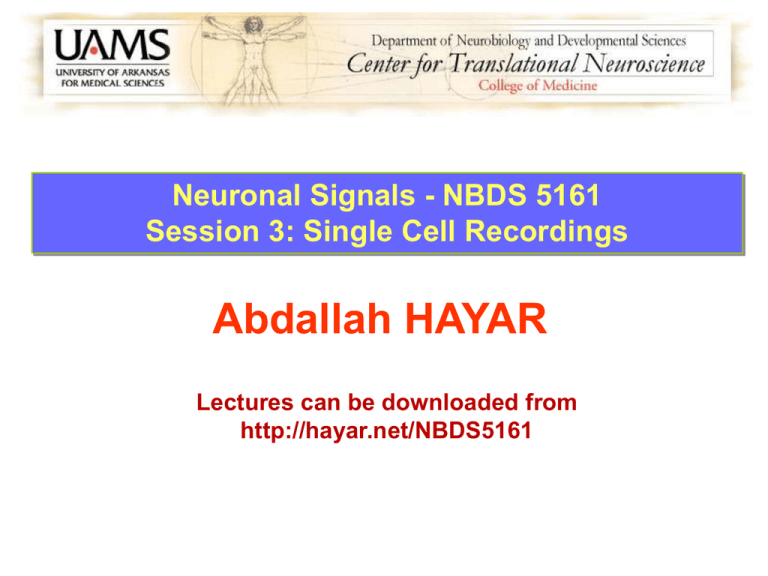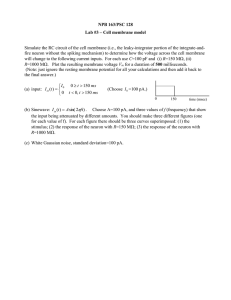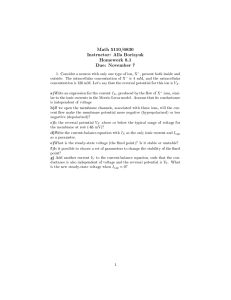Neuronal Signals
advertisement

Neuronal Signals - NBDS 5161 Session 3: Single Cell Recordings Abdallah HAYAR Lectures can be downloaded from http://hayar.net/NBDS5161 Updated Tentative Schedule for Neuronal Signals (NBDS 5161) One Credit–Hour, Summer 2010 Location: Biomedical Research Building II, 6th floor, conference room, Time: 9:00 -10:20 am Session 1 2 3 4 5 6 7 8 9 10 Day Tue Thu Thu Fri Mon Wed Fri Mon Wed Fri Date 6/1 6/3 6/10 6/11 6/14 6/16 6/18 6/21 6/23 6/25 11 12 13 Fri Mon Wed 7/9 7/12 7/14 Topic Design of an electrophysiology setup Neural population recordings Single cell recordings Analyzing synaptic activity Data acquisition and analysis Analyzing and plotting data using OriginLab Detecting electrophysiological events Writing algorithms in OriginLab® Imaging neuronal activity Laboratory demonstration of an electrophysiology and imaging experiment Article presentation I: Electrophysiology Article presentation II: Imaging Exam and students’ survey about the course Instructor Hayar Hayar Hayar Hayar Hayar Hayar Hayar Hayar Hayar Hayar Hayar Hayar Hayar Student List 1 Name Simon, Christen E-mail CSimon@uams.edu Regular/Auditor Regular (form signed) Regular (form signed) Regular (form signed) Regular (form signed) Regular (form signed) Regular (form signed) Regular (form signed) Department Neurobiology & Developmental Sciences Neurobiology & Developmental Sciences Neurobiology & Developmental Sciences Pediatrics 2 Kezunovic, Nebojsa NKezunovic@uams.edu 3 Hyde, James R JRHyde@uams.edu 4 KYadlapalli@uams.edu 5 Yadlapalli, Krishnapraveen Pathan, Asif 6 Kharade, Sujay SKHARADE@uams.edu 7 Howell, Matthew MHOWELL2@uams.edu 8 Beck, Paige B PBBeck@uams.edu College of Medicine KMThakali@uams.edu Regular (form signed) Auditor (form signed) Auditor (form not signed) Unofficial auditor 9 Atcherson, Samuel R SRAtcherson@uams.edu 10 Detweiler, Neil D NDDETWEILER@uams.edu 11 Thakali, Keshari M 12 Boursoulian, Feras FBoursoulian@uams.edu Unofficial auditor 13 Steele, James S JSSTEELE@uams.edu Unofficial auditor Neurobiology & Developmental Sciences College of Medicine 14 Smith, Kristen M KMSmith2@uams.edu Unofficial auditor 15 Gruenwald, Konstantin kjoachimg@gmail.com Unofficial auditor Yang, Dong YangDong@uams.edu Unable to attend APATHAN@uams.edu Pharmacology & Toxicology Pharmacology & Toxicology Pharmacology & Toxicology Audiology & Speech Pathology Pharmacology & Toxicology Pharmacology & Toxicology Neurobiology & Developmental Sciences Neurobiology & Developmental Sciences Pediatrics Pulmonary Position Graduate Neurobiology – Mentor: Dr. Garcia-Rill Graduate Neurobiology – Mentor: Dr. Garcia-Rill Graduate Neurobiology – Mentor: Dr. Garcia-Rill Research Technologist – Mentor: Dr. Alchaer Graduate Pharmacology – Mentor: Dr. Rusch Graduate Pharmacology – th 4 year - Mentor: Dr. Rusch Graduate Interdisciplinary rd Toxicology - 3 year Mentor: Dr. Gottschall nd Medical Student – 2 Year Mentor: Dr. Garcia-Rill Assistant Professor Graduate Pharmacology – st 1 year Postdoctoral Fellow – Mentor: Dr. Rusch Postdoctoral Fellow – Mentor: Dr. Hayar st Medical Student – 1 Year – Mentor: Dr. Hayar Research Technologist – Mentor: Dr. Garcia-Rill High school Student – Mentor: Dr. Hayar Research Assistant – Accepted in Neuroscience FIGURE 1 Intracellular recording of the membrane potential and action potential generation in the squid giant axon. (A) A glass micropipette, about 100 µm in diameter, was filled with seawater and lowered into the giant axon of the squid after it had been dissected free. The axon is about 1 mm in diameter and is transilluminated from behind. (B) One action potential recorded between the inside and the outside of the axon. Peaks of a sine wave at the bottom provided a scale for timing, with 2 ms between peaks. From Hodgkin and Huxley (1939). Intracellular vs. Extracellular recordings Extracellular waveform is almost derivative of intracellular Intracellular recordings: Sharp vs. Patch clamp recording Sharp Patch clamp Pipette solution 3000 mM KCl or KAc Mainly 124 mM Kgluconate or CsMeSO4 +ATP +GTP Tip Diameter 0.1 µm, sharp enough to impale the cell 1-2 µm, seal with the plasma membrane Seal with membrane Leaky seal GigaOhm tight seal Stability of recording Stable with no significant rundown of membrane properties Rundown of the properties of membrane channel Dialysis Excess chloride or acetate leaks into the cell Intracellular messengers and soluble enzymes will diffuse out of the cell Membrane resistance Will appear lower because of leak: ex 30 MOhm Accurate measurement ex 300 MOhm Electrode resistance 60-120 MOhm 3-8 MOhm Space clamp Cannot do adequate voltage clamping, better for current clamp Much better access to cell, can record in voltage clamp Pharmacology Drugs or fluorescent dyes diffuse very slowly into cell Can block potassium channel by intracellular cesium and sodium channel by QX-314 Combining anatomy and immunocytochemistry with patch-clamping Micro-beads injection Microbeads and Lucifer Yellow IR-DIC Tyrosine hydroxylaseimmunocytochemistry Green microbeads A1 A2 B1 B2 Lucifer yellow 10 µm Historical Background Neher and Sakmann Ion channels Following Hodgkin & Huxley’s results in the 1950’s two classes of transport mechanisms competed to explain their results: carrier molecules and pores - and there was no direct evidence for either. It was not until the 1970’s that the nicotinic ACh receptor and the Na+ channel were chemically isolated, purified, and identified as proteins. The technical breakthrough of the patch-clamp techniques developed by Neher and Sakmann (1976) allowed them to report the first direct measurement of electrical current flowing through a single channel for which they received the 1991 Nobel prize. Patch-clamp recording from a single ACh-activated channel on a cultured muscle cell with the patch clamped to -80mV. Openings of the channel (downward events) caused a unitary 3 pA current to flow, often interrupted by a brief closing. Notice the random openings and closing, characteristic of all ion channels. Reproduced from Sigworth FJ (1983) An example of analysis in Single Channel Recording, eds. Sakmann B, Neher E. Pp 301-321. Plenum Press. Dissecting the Brain Vibratome® 3000 Deluxe The principle of the VIBRATOME is a Vibrating blade intersecting the specimen underneath the surface of a liquid bath, which lubricates the cut. Next there are 5 parameters under the control of the operator: 1. Nature of the bath (usually a physiologically compatible buffer). 2. Temperature of the bath (the softer the specimen, the colder the bath should be). 3. Speed (the softer the specimen, the slower the speed). 4. Amplitude (the softer the specimen, the higher the amplitude). 5. Blade Angle (the softer the specimen, the steeper angle of attack required). General rules for brain Bath – cold (2 – 6 degrees C.) Speed – slow (setting 1-2 or less) Amplitude – High (8 +/-) Blade Angle – Steep (25 degrees +/-) Embedding when necessary (i.e. Fresh brain at 20 microns). Do not use agar. Use 2-5% neutral agarose. Trial and error on the exact concentration. The trick is to match the density of the agarose with that of your specimen. Vibratome makes no claim for less than 20-micron sections using a standard razor blade. However, many people have successfully cut firmer specimens at 10 microns using a glass or sapphire knife. Electrophysiological and imaging setup •Olfactory bulb slices (400 µm thick) were cut from young rats (21- 30 days). •Single and paired whole-cell current and voltage clamp recordings were made at 30°C; drugs applied by perfusion. •Recorded neurons filled with Lucifer Yellow and biocytin and their morphology was reconstructed. •Olfactory nerve (ON) electrical stimulation. P-1000 & P-97 PIPETTE COOKBOOK 2009 http://www.sutter.com/contact/faqs/pipette_cookbook.pdf Standard or Thick Walled Glass 1.0mm x 0.5mm glass, 0.06μm Tip, 12mm taper (400x mag.) Thick Walled Glass (400X mag) 1.5mm x 0.86mm glass, ~2μm Tip, 3-4 mm taper General Look Up Tables - Prog #51, four to five loops Micropipette Accessories http://www.siskiyou.com/stable-tip-electrode-holder.shtml The new ST50 Stable-tip electrode holders eliminate the final instability link in the electrophysiology experimental setup. We’ve taken a thermally stable base material and coated it with alumina oxide. This coating has two benefits: first, it is non-conductive so the holder does not act as an electrical antenna; second, it is very resistant to corrosion. http://www.wpiinc.com/ Standard Glass Capillaries WPI Cat# 1B150F-3 3 in. (76 mm) 1.5 / 0.84 OD/ID (mm) Filament •MicroFil 28g, 28 gauge •250 um ID •350 um OD •67 mm long WPI Cat# MF28G67-5 Silver Wire: 30 AWG, 0.25 mm, diameter ,10 ft WPI Cat# AGW1010 24 AWG, 0.5 mm, diameter, 30 ft WPI Cat# AGW2030 Micropipette Storage Jar for 1.5 mm OD micropipettes, WPI Cat# E215 Fabrication of Patch Pipettes -A thick wall (0.2 - 0.3 mm) generates lower electrical noise and increases bluntness at the tip, thereby preventing penetration into the cell during seal formation. -To obtain blunter tip, better use multistage electrode pullers. -To lower the noise, coat the pipette up to within 100 µm from its tip with Sylgard#184, a hydrophobic material -To promote gigaohm seals and to reduce the possibility of tip penetration into the cell during seal formation, pipette tips should be fire-polished. - Glasses with the lowest loss factor (describes dielectric properties) exhibit the lowest noise. The Silver/Silver Chloride Electrode -The flowing electric charge is typically carried by moving electrons in a conductor such as a wire; whereas in an electrolyte, it is instead carried by ions. -The Ag/AgCl electrode is reversible (current can flow in both directions) -If electrons flow from the copper wire through the silver wire to the electrode AgCl pellet, they convert the AgCl to Ag atoms and the Cl- ions become hydrated and enter the solution. - If electrons flow in the reverse direction, Ag atoms in the silver wire that is coated with AgCl give up their electrons (one electron per atom) and combine with Cl ions that are in the solution to make insoluble AgCl. -This electrode perform well only in solutions containing chloride ions. -If the 2 electrodes face different Clconcentrations (for instance, 3 M KCl inside a micropipette* and 120 mM NaCl in a bathing solution surrounding the cell), there will be steady potential difference, termed liquid junction potential, which can be subtracted electronically 4.0 mm dia. x 1 mm Ag/AgCl Electrode Correction for liquid junction potentials in patch clamp experiments Clampex - Tools – Junction Potential Experimentally: -Fill an electrode pipette with intracellular solution -Fill the bath with the same intracellular solution and insert electrode into bath -Use Current clamp mode and adjust pipette offset potentiometer to zero the voltage read on the meter -Change the bath solution to aCSF or extracellular solution -Read the voltage, it should be around -10 mV. -The Junction potential should be -(-10)=+10 mV -Your Real resting potential should be Vmeasured - Junction Potential -Note: It is recommended that the reference electrode is a 2-3 M KCl microelectrode or a 2-3 M KCl agar bridge Calculation: The second option is to calculate the LJP using a generalized version of the Henderson equation (Barry and Lynch, 1991; Barry, 1994). JPCalc software, developed by Peter Barry, is one such calculator. Although JPCalc was designed to be stand-alone software, it is incorporated into Clampex. Patch Clamp Applications Cell-Attached vs. Whole Cell: Bursting exhibit rundown in whole-cell recording Burst timing may be regulated by spontaneous fast synaptic currents IPSCs EPSC Confocal imaging of neurons filled with fluorescent dyes during patch clamping Pedonculopontine neurons Purkinje cells Patch clamp Measure opening and closing of single ACh receptor channels Opening & closing rates are almost instantaneous. Small depolarizations that occur last ~2 msec and are ~0.25 microvolts in amplitude. The mean open time = t1/2 of decay of the MEPP FIGURE 3 The equilibrium potential is influenced by the concentration gradient and the voltage difference across the membrane. Neurons actively concentrate K+ inside the cell. These K+ ions tend to flow down their concentration gradient from inside to outside the cell. However, the negative membrane potential inside the cell provides an attraction for K+ ions to enter or remain within the cell. These two factors balance one another at the equilibrium potential, which in a typical mammalian neuron is -102 mV for K+. FIGURE 2 Differential distribution of ions inside and outside plasma membrane of neurons and neuronal processes, showing ionic channels for Na+, K+, Cl-, and Ca2+, as well as an electrogenic Na+–K+ ionic pump (also known as Na+, K+–ATPase). Concentrations (in millimoles except that for intracellular Ca2+) of the ions are given in parentheses; their equilibrium potentials (E) for a typical mammalian neuron are indicated. A Net Current Alters the Membrane Potential Resting Potential Depolarization Hyperpolarization K+ K+ Na+ INa = IK K+ Na+ INa > IK Na+ INa < IK The Nernst equation has a physiological application when used to calculate the potential of an ion of charge z across a membrane. This potential is determined using the concentration of the ion both inside and outside the cell: # R is the universal gas constant # T is the absolute temperature # z is the number of electrons # F is the Faraday constant, the number of coulombs per mole of electrons The Goldman-Hodgkin-Katz voltage equation, more commonly known as the Goldman equation is used in cell membrane physiology to determine the potential across a cell's membrane taking into account all of the ions that are permeant through that membrane. Voltage drop across the resistor "V" is in volts, abbreviated "V". The abbreviation "V" for "volts" is not to be confused with the voltage "V" in Ohm's law. Current "I" is in amperes, often shortened to "amps", abbreviated "A". Resistance "R" is in ohms, often represented by the Greek symbol capital omega (Ω). "K" or "k" signifies a multiplier of a "thousand" ohms, 1,000 Ω = 1 KΩ "M" or "MEG" signifies multiplier of a "million" ohms. 1,000,000 Ω = 1 M Ω Giga ohm = 1,000,000,000 Ω = 1 G Ω Resistors Resistors are elements of electrical networks and electronic circuits and are ubiquitous in most electronic equipment. The electrical resistance of an object is a measure of its opposition to the passage of a steady electric current. Discovered by Georg Ohm in the late 1820s, electrical resistance shares some conceptual parallels with the mechanical notion of friction. The SI unit of electrical resistance is the ohm, symbol Ω. Resistance's reciprocal quantity is electrical conductance measured in siemens, symbol S. For resistors in series For resistors in parallel Summation of Conductance In electrophysiology, it is convenient to discuss currents in terms of conductance because side-by-side ("parallel“) conductances simply summate. The most important application of the parallel conductances involves ion channels. When several ion channels in a membrane are open simultaneously, the total conductance is simply the sum of the conductances of the individual open channels. Conductances in parallel summate together, whether they are resistors or channels. A capacitor or condenser is a passive electronic component consisting of a pair of conductors separated by a dielectric. When a voltage potential difference exists between the conductors, an electric field is present in the dielectric. Dielectric is placed between two conducting plates, each of area A and with a separation of d. For capacitors in series For capacitors in parallel Capacitors in Parallel Add Their Values When multiple capacitors are connected in parallel, this is electronically equivalent to a single large capacitor; that is, the total capacitance is the sum of their individual capacitance values. Thus, membrane capacitance increases with cell size. Membrane capacitance is usually expressed as value per unit area; nearly all lipid bilayer membranes of cells have a capacitance of 1 µF/cm2 (0.01 pF/µm2). RC circuit: A membrane behaves electrically like a capacitance in parallel with a resistance. A simple resistor-capacitor (RC) circuit is a capacitor and a resistor in series. The capacitor discharges its energy into the resistor. This voltage across the capacitor over time could be found through Kirchhoff's current law, where the current coming out of the capacitor must equal the current going through the resistor. The time constant τ (in seconds) is: R is the resistance (in ohms) and C is the capacitance (in farads). The resistance across the membrane is a function of the number of open ion channels The capacitance is a function of the properties of the lipid bilayer. http://www.ncbi.nlm.nih.gov/books/bv.fcgi?rid=neurosci.box.192 Equivalent circuit for the whole-cell configuration Why study voltage clamping? •Historical: This is the method invented by Hodgkin and Huxley to discover the voltage-dependent behavior of sodium and potassium currents. •Factual: To understand the voltage and time dependence of sodium and potassium currents underlying the action potential. •Methodological: •The same method, in principle, is still used to study many other types of membrane currents (calcium currents, chloride currents, pump currents, etc.) •The same method is used to study the currents that go through single ion channels. Voltage Clamp 1-electrode voltage clamp 2-electrode voltage clamp Fig. 5. The voltage-clamp technique keeps the voltage across the membrane constant so that the amplitude and time course of ionic currents can be measured. In the twoelectrode voltage-clamp technique, one electrode measures the voltage across the membrane while the other injects current into the cell to keep the voltage constant. The experimenter sets a voltage to which the axon or neuron is to be stepped (the command potential). Current is then injected into the cell in proportion to the difference between the present membrane potential and the command potential. This feedback cycle occurs continuously, thereby clamping the membrane potential to the command potential. By measuring the amount of current injected, the experimenter can determine the amplitude and time course of the ionic currents flowing across the membrane. Voltage Clamp The voltage clamp is used by electrophysiologists to measure the ion currents across a neuronal membrane while holding the membrane voltage at a set level. Neuronal membranes contain many different kinds of ion channels, some of which are voltage gated. The voltage clamp allows the membrane voltage to be manipulated independently of the ionic currents, allowing the current-voltage relationships of membrane channels to be studied • • • • • Measure VM = Inside Outside Choose Clamp potential (VC) Calculate VC - VM Inject current = g (VC - VM) • If VC > VM, current is positive – Membrane potential increases – VC - VM decreases • If VC < VM, current is negative – Membrane potential decreases – VC - VM decreases Early inward current – Negative current injected by clamp to maintain membrane potential. – Negative current is compensating inward flow of positive ions – Transient current • Later outward current – Positive current injected to compensate for outward flow of positive ions – Persistent current Voltage clamping: 3 principles (1) Injecting positive current into the cell depolarizes the cell (injecting negative current hyperpolarizes it). Depolarizing response Hyperpolarizing response V V I I (2) When current is injected into the cell, it takes some time to hyperpolarize/depolarize the cell because the cell’s capacitance must be charged/discharged. (3) When there is no net flow of ions into the cell, the membrane potential doesn’t change. FIGURE 7 Generation of the action potential is associated with an increase in membrane Na+ conductance and Na+ current followed by an increase in K+ conductance and K+ current. Before action potential generation, Na+ channels are neither activated nor inactivated (illustrated at the bottom of the figure). Activation of Na+ channels allows Na+ ions to enter the cell, depolarizing the membrane potential. This depolarization also activates K+ channels. After activation and depolarization, the inactivation particle on the Na+ channels closes and the membrane potential repolarizes. The persistence of the activation of K+ channels (and other membrane properties) generates an afterhyperpolarization. During this period, the inactivation particle of the Na+ channel is removed and the K+ channels close. From Huguenard and McCormick.61 Comparison of Na+ and K+ Currents following a Depolarization Na+ influx opens Na+ channels depolarization opens K+ channels K+ efflux repolarization closes K+ channels Voltage clamp: what is the behavior of voltage dependent sodium current? The pharmacological method: Block the potassium current with a drug: tetraethylammonium. The voltage-dependent current that remains is the voltage-dependent sodium current. V -10 mV -65 mV In the presence of tetraethylammonium (TEA) I 1 msec Voltage clamp: what is the behavior of voltage dependent sodium current? The pharmacological method: Block the potassium current with a drug: tetraethylammonium. The voltage-dependent current that remains is the voltage-dependent sodium current. Note: even with a constant voltage, the sodium current first increases, and then automatically, while the depolarization is maintained, the current decreases (inactivation) Na current V -10 mV -65 mV Voltage clamp: what is the behavior of voltage dependent potassium current? Pharmacological method: Block the voltage-dependent sodium current with tetrodotoxin. The current that remains is the voltage-dependent potassium current. V -10 mV In the presence of tetrodotoxin (TTX) -65 mV I Note: (1) the potassium current is slower to activate than the sodium current. Therefore, sometimes called “delayed current” (2) the potassium current is maintained for as long as the depolarization is maintained. (only closes after repolarization) Voltage clamp: what is the behavior of voltage dependent potassium current? Pharmacological method: Block the voltage-dependent sodium current with tetrodotoxin. The current that remains is the voltage-dependent potassium current. V -10 mV In the presence of tetrodotoxin (TTX) -65 mV I Note: (1) the potassium current is slower to activate than the sodium current. Therefore, sometimes called “delayed current” (2) the potassium current is maintained for as long as the depolarization is maintained. (only closes after repolarization) Fig 13. Two different patterns of activity generated in the same neuron, depending on membrane potential. (A) The thalamic neuron spontaneously generates rhythmic bursts of action potentials due to the interaction of the Ca2+ current IT and the inward "pacemaker" current Ih. Depolarization of the neuron changes the firing mode from rhythmic burst firing to tonic action potential generation in which spikes are generated one at a time. Removal of this depolarization reinstates rhythmic burst firing. This transition from rhythmic burst firing to tonic activity is similar to that which occurs in the transition from sleep to waking. (B) Expansion of detail of rhythmic burst firing. (C) Expansion of detail of tonic firing. From McCormick and Pape (1990). Voltage Dependent Channels • • • • Diversity of firing patterns produced by myriad voltage dependent channels Channels differ by – Ion selectivity (e.g. K, Na, Ca) – Distribution (Dendrites, soma, axon) – Activation and Inactivation properties – Sensitivity to drugs Sodium channel has two types of gates – Activation gate • Opens with depolarization • Closes with hyperpolarization – Inactivation gate • Closes with depolarization • Opens with hyperpolarization Current flows when both gates open Terminology • Activation – Turning on of current with depolarization • De-activation – Turning off of current with repolarization • Inactivation – Turning off of current with sustained depolarization • De-inactivation – Removal of inactivation (block) by repolarization Sodium Currents • • Transient, INaF – Responsible for Action Potential Persistent, INaP – Threshold near resting potential – Origin: • Window current, or • Different gating mode of INaF, or • Separate channel protein Function of Persistent current -Enhancement of subthreshold synaptic potentials -Depolarization activates INaP, => more depolarization -Hyperpolarization de-activates INaP, which produces more hyperpolarization Plateau potential -Prolonged potential that remains after synaptic inputs or current injection is removed -Contributes to persistent firing Persistent sodium current is activated by a slow depolarizing voltage ramp (> -60 mV) and is blocked by Tetrodotoxin (TTX) Bursting is mediated by sodium channel activation and is blocked by intracellular application of a sodium channel blocker QX-314 FIGURE 12 Simulation of the effects of the addition of various ionic currents to the pattern of activity generated by neurons in the mammalian CNS. (A) The repetitive impulse response of the classical Hodgkin–Huxley model (voltage recordings above, current traces below). With only INa and IK, the neuron generates a train of five action potentials in response to depolarization. Addition of IC (B) enhances action potential repolarization. Addition of IA (C) delays the onset of action potential generation. Addition of IM (D) decreases the ability of the cell to generate a train of action potentials. Addition of IAHP (E) slows the firing rate and generates a slow afterhyperpolarization. Finally, addition of the transient Ca2+ current IT results in two states of action potential firing: (F) burst firing at -85 mV and (G) tonic firing at -60 mV. From Huguenard and McCormick (1994).


